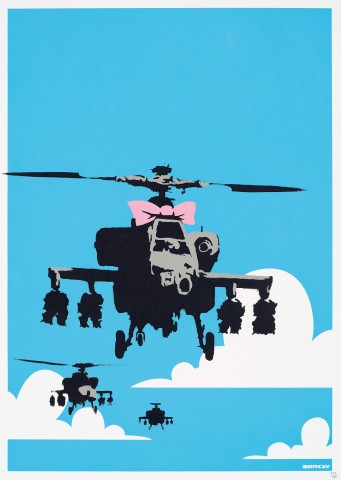HAPPY CHOPPERS, 2003
BANKSY
colour screenprint
70.0 x 50.0 cm (sheet)
signed in image lower right: BANKSY
numbered below image lower right
published by Pictures on Walls, London
This work is accompanied by a certificate of authenticity from Pest Control, London
Museum of Contemporary Art, Sydney
Private collection, Brisbane, acquired from the above in 2003
Santa’s Ghetto, Carnaby Street, London, 2 – 24 December 2003 (another example)
Cripps, C., ‘Graffiti with bells on’, The Independent, London, 1 December 2003
Banksy, Cut it Out, Weapons Of Mass Disruption, 2004, np (illus., another example)
Banksy, who although like a latter-day Robin Hood remains officially anonymous, is a street artist who has become household name around the world, with a reach far beyond the Bristol underground scene from which he emerged in the early 1990s. His stencilled compositions use visual metaphors to illustrate the corruption of innocence by war, environmental degradation and totalitarian regimes, and in many cases were first sprayed by the artist to directly onto street walls in prominent junctions of cities before being refined into commercial silk-screen prints. This is the case for Happy Choppers, a contradictory image of a squadron of military helicopters adorned with quaint ribbons which has become an iconic motif within Banksy’s repertoire, first used on hoardings in suburban London in 2002 and notably transformed into a guerrilla meme during the global 2003 protests against the Iraq War.
One of three motifs by Banksy (along with designs known as Bomb Hugger and Grin Reaper) used on cardboard placards in the London protests of the 15th of February 2003, the Happy Choppers design was printed in black and yellow with the words “wrong war” and carried by the artist’s friends in what was reported at the time to be the largest civil protest event in history, with an estimated 6-10 million people participating in over 600 cities around the world. The faithful outline of an American Apache AH-64 helicopter, known colloquially as a ‘chopper’, is undercut, rendered ridiculous and all the more menacing by the placement of a ribbon atop the deadly machinery, just under its rotor blades, like the ribbon in the hair of a young girl, or a gift-wrapped present. In addition to sarcastically deriding the chauvinism of war, Banksy uses the bow as a metaphor for the masking of intentions, and cute and facile attempt to render the casus belli palatable, noble and just in the eyes of the public. This was a particularly pertinent statement in the political climate of late 2002- early 2003, mirroring the public opinion of perceived disingenuousness in the motives for an invasion of Iraq - marketed as aligned with a fight for democracy and neutralizing the threat of weapons of mass destruction rather than concerning access to petroleum. Banksy would later reinforce this message with a series of appropriated landscape paintings overlaid with the same stencil, titled Crude Oil.
Later in 2003 Bansky published an edition of Happy Choppers as a silk-screen print, in an edition of 750 (the first 150 of which were hand-signed), to be exhibited and sold in an ephemeral festive group show called Santa’s Grotto, an initiative that would become an annual event for the artists of the co-operative Pictures with Walls. Described in the press at the time as a ‘festive extravaganza of cheap art and related novelty goods from low-brow artists and trained vandals’, Santa’s Grotto sold limited edition prints cheaply from squatted premises in the trendy retail district of London’s SoHo.1 This finished and resolved composition of Happy Choppers features a trio of heavily armed apache helicopters, contour-printed in two tones of grey, placed in a convoy receding into the distance, cleanly visible against a bright blue sky, complete with cartoon-like billowing white clouds. As opposed to the skewed urgency of the disposable earlier versions of Happy Choppers, these helicopters are printed perfectly level on the picture plane, in higher definition. The imminent danger they pose is not concealed nor rushed. Their inexorable progress toward the viewer is slow, preordained, and unashamed.
In taking a quick, resource-efficient method of creating artwork (aerosol and stencil cut-out) and applying it to mass-distributed media, Banksy reacts and comments on current events almost immediately, creating valuable visual records of the anti-war and anti-establishment zeitgeist of the turn of the millennium. Challenging public opinion with humour, Banksy’s incisive social satire lobbies for moral accountability and a healthy skepticism of authority and media spin.
1. Cripps, C., ‘Graffiti with bells on’, The Independent, London, 1 December 2003
LUCIE REEVES-SMITH
